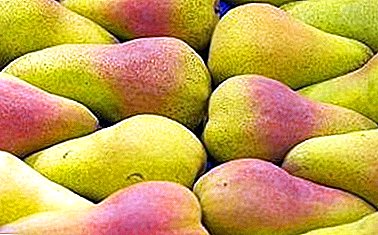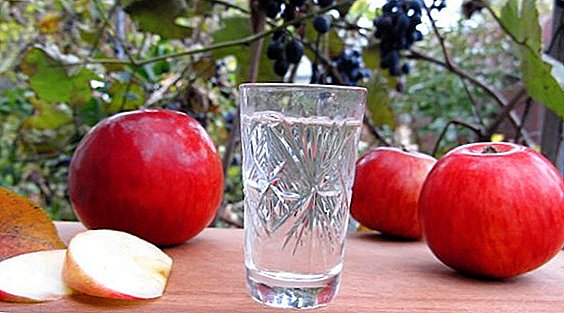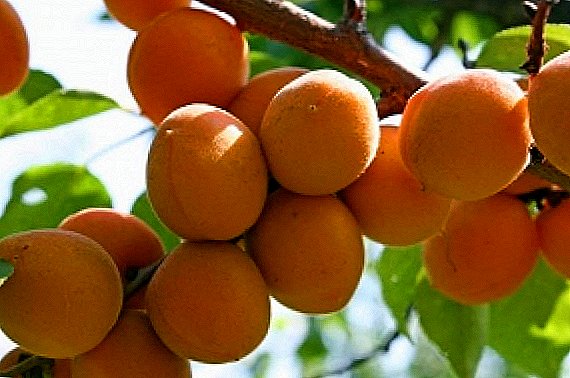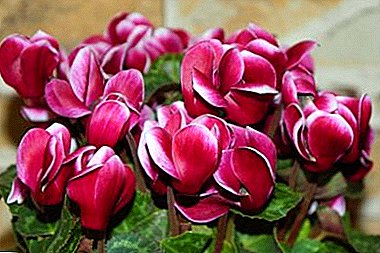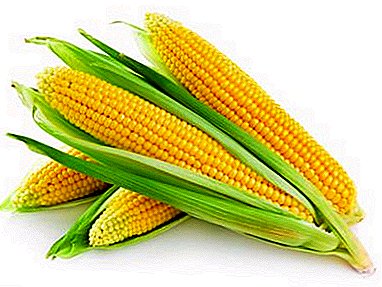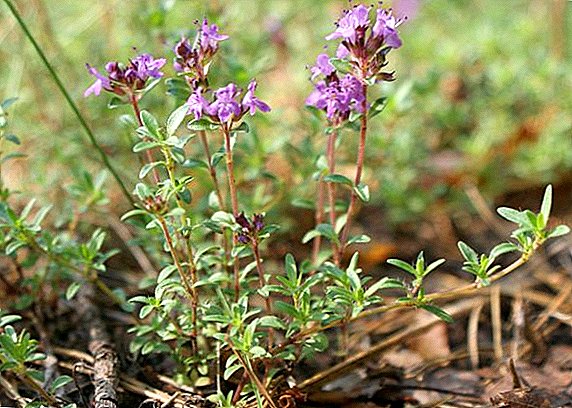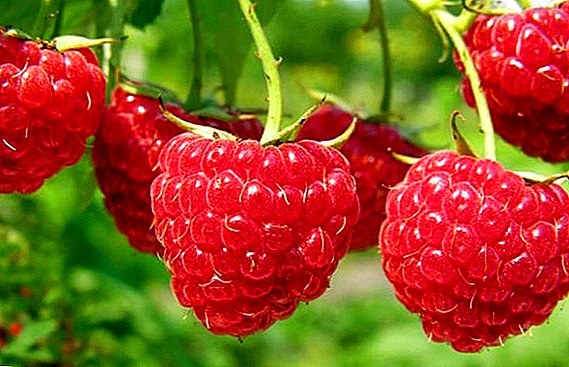 New and fashionable large-fruited raspberry varieties are more and more conquering the hearts of gardeners and places on their plots.
New and fashionable large-fruited raspberry varieties are more and more conquering the hearts of gardeners and places on their plots.
Of course, it is pleasant to pick a berry from a stalk that does not have thorns; It is pleasant to eat a huge berry and you can successfully sell it. These varieties appeared relatively recently and do not always withstand the struggle with the weather during prolonged droughts or frosts.
But the old and reliable varieties that give crops for many decades, are still good, their yield is also reliable. And let the berry a little smaller, but it is always a lot, it is tasty and fragrant.
One of these varieties is the old, proven variety of raspberry Novost Kuzmina. Let's take a look at what this variety is, how to care for it, how to plant and multiply it.
Breeding history
The Novost Kuzmin raspberry variety is more than one hundred years old; it was obtained by Kuzmin N.V. as a result of selection work with two raspberry varieties: the Russian variety Smolenskaya and the American variety Kutbert.
The first viable seedlings of this variety with already fixed properties were obtained in 1880 in the Nizhny Novgorod region.
Description and characteristics of the variety
"News Kuzmina" - mid-season variety, unpretentious to the conditions of cultivation, hardy to temperature changes. It can be grown both on an industrial scale and in individual gardening areas.
Berry has good taste and classic raspberry flavor. This raspberry is easy to grow, even for gardeners who have little experience. 
Bushes
The raspberry bush is tall, with an erect stem, its height reaches 2-2.5 meters. The upper part of the stem (15-30 cm) is slightly tilted. The variety has good winter hardiness and stable yield.
Raspberry "News Kuzmina" gives quite a bit of young shoots for breeding, grown by September, well-leafed growth, has a green stem with a waxy coating.
The side of the stems facing the sun can change color from green to purple.
Fruiting raspberries occurs on last year's shoots, which, having survived the winter, become light yellow with a slightly whitish bloom.  Fruiting shoots with thorns on the stems, spines a lot, they are thin and dark burgundy. At the base of the spike there is a thickness of 3-4 mm thick, maroon-brown color.
Fruiting shoots with thorns on the stems, spines a lot, they are thin and dark burgundy. At the base of the spike there is a thickness of 3-4 mm thick, maroon-brown color.
Starting from ground level, shoots are covered with thorns very thick, but from the middle of the stem to the top their number decreases, they become coarser and thicker.
On the shoots of last year, the color of the stem and thorns is the same, the shape of the leaf plate is three-leafed, strongly corrugated.
Check out the best varieties of black and yellow raspberries."News Kuzmina" - a plant semi remontant, that is, it can give a small second crop of berries. Before fruiting, the stems must be tied to supports, as they tend to wilt under the weight of the crop. Berries begin to sing closer to the middle of summer
Berries
This variety has a high yield, the berries are easy to collect, they are easily separated from the stone. When delaying the harvest - the berries are not showered for a long time.  Yield characteristic:
Yield characteristic:
- the berry is colored red, without a characteristic luster (rather dull);
- fruits are not very large, medium size;
- the weight of one berry is 2-4 grams, the shape of the berry is stupidly-conical, slightly oval;
- in full ripeness, the flesh is sweet and slightly sour, soft and juicy;
- the berry is dense, does not crumble into fragments, when removed it is kept whole.
Did you know? Time-tested folk recipes suggest using raspberries as an effective remedy for colds. For the treatment of used berries and leaves, brew tea from them for colds or flu. Raspberry jam is used as a febrifuge. Official medicine recognizes dried raspberry berry as an excellent diaphoretic. Raspberry syrup is the basis (softening the unpleasant taste) for many bitter medicines.
Terms of ripening
The first berries ripen on the bushes in the second half of July. Fruiting in raspberry jam lasts a little more than twenty days.
In a dry year, the berry can finish its fruiting faster. With frequent rains and the absence of the sun, the raspberry harvest is much more acidic. 
Yield
Berry bush has a good yield. Based on the technical description of the variety and practical observations of gardeners - the yield from one raspberry bush of the Novost Kuzmin variety is 800 grams of berries, or 2 kilograms of fruit from one square meter of raspberries. Harvest in a day, as the berries ripen.
Use of berries
Since the berry is soft and not very transportable, it is not possible to transport it over long distances. Berries of this variety are used mainly for winter preparations (jam, stewed fruit, jelly, confiture) and for fresh food.
Grandma's raspberry confiture recipe: 1 kg of fresh berries take 1 kg of sugar. The berries are well kneaded in a blender or by hand and put in a container with a thick bottom on a small fire. Sugar is added to the ground berry.
Stir and heat the mixture for about ten minutes, until the moment when the sugar melts. After that, wait for the mixture to boil and (without boiling it) immediately turn off the burner.
Hot confiture is poured into jars. When cooling down, it thickens and is gelled. 
How to choose seedlings when buying
In order not to buy a “cat in a bag,” it is better to purchase seedlings in berry nurseries with good recommendations, or from private collectors - gardeners. Saplings for planting can be dug in spring and autumn.
Saplings dug from autumn are stored in winter at appropriate temperatures (not higher than 5-8 ° C). Storing seedlings without damage to the root system is possible in the excavation of the earth, or in underground storage facilities (cellars).
Learn more about other raspberry varieties: Cumberland, Hercules, Caramel, Hussar, Heritage, Hercules, Atlant, Gusar, Caramel, Ispolin, Polka , "Yellow Giant", "Canadian".During winter storage, the roots of raspberry seedlings are sprinkled with wet peat substrate or sawdust, this allows preserving the root turgor (moisture and elasticity).
When the buyer has decided on the producer from whom he wants to purchase planting material, he needs to inspect the seedlings before buying.  They must meet the following requirements:
They must meet the following requirements:
- above the roots (at the base of the stem) there must be at least three living buds, two or three fruit-bearing branches will grow from these buds on the plant in the future;
- the root system of the seedling must be well developed, fibrous and dense;
- stem diameter of young raspberries must be at least 0.8 cm;
- the length of the stems of raspberry seedlings is absolutely not important, they are often sold already cut off.
Raspberries are prone to quick drying of the root system, so purchased seedlings turn into a damp cloth (roots). Immediately after arriving at the site of the plant, it is desirable to land on a permanent, pre-prepared place for them.
If you have bought seedlings with a long stem, when landing in the ground, they should be cut with a garden pruner, leaving a height of about 15-20 cm above the ground.
Important! Particularly suspicious or once burnt on the fraud buyers, gardeners can recommend to buy seedlings, on which there are a few berries. Fruiting is, of course, stress for a young plant, but so the buyer can be sure that he is buying the declared variety. Bought seedlings when planting need to cut mercilessly.

Choosing the right place
Raspberry varieties "News Kuzmina" need to be planted in a protected (fence, wall of the house, the wall of the barn) from the cold north winds places. It is best to have the rows of raspberry trees from south to north, so the berry will be better during the daylight and longer lit by the sun's rays.
Lighting
If the location of the site does not allow to plant raspberries in the sun - seedlings can be arranged for permanent residence in partial shade. In such a place raspberries will require less watering, but the berry will be less large and sweet.
The soil
In order to fruit well berry, it must be arranged on fertile, loose soils with a good, regular flow of moisture.
If the natural soil on the site is not fertile enough, its composition should be improved with the help of mineral substances (chalk, lime, sand) and fertilizers (humus, manure, humus). These substances need to be made in the required proportions in the soil and dig it.
Did you know? At the end of the XIX century in the city of Geneva breeders first managed to bring a variety of raspberries with unusual purple berries. Raspberry varieties with red and black fruits became the basis for selection work.

Site preparation
After the gardener has decided on the place where the new raspberries will be laid - you need to prepare a place for the beds.
What stages of soil preparation are needed before planting seedlings:
Step number 1 - preliminary marking the boundaries of future beds. It should be borne in mind that the width of the bed of raspberry do not exceed one and a half meters. The length of the berry beds is at the discretion of the owner, often this is due to the shape and size of the garden plot.
If standard raspberry varieties are planted on berry beds (height up to 1.4 m), then the distance between two beds can be left within one and a half meters.
If a berry is planned to be planted with tall raspberry varieties (from 1.7 to 3.0 m), then the row-spacing must be at least two meters.
When marking the boundaries of the future bed it is convenient to use stretched cords (ropes). For raspberry "News Kuzmina" suitable option with wide, two-meter spacing.  Step number 2 - tab fertilizer in the soil beds. Raspberries can grow on organic-poor lands, but a gardener can get a bountiful harvest of large and sweet berries only on fertilized and well-moistened lands.
Step number 2 - tab fertilizer in the soil beds. Raspberries can grow on organic-poor lands, but a gardener can get a bountiful harvest of large and sweet berries only on fertilized and well-moistened lands.
Raspberry "News Kuzmina" loves fertile, slightly acidic soil (with PH 5.5-6.5). If the soil on your site does not meet these requirements, as it is too acidic or clayey, this can be corrected by adding lime — fluff or wood ash.
The substance should be spread evenly over the surface of the beds at the rate of: 500 grams of lime - per square meter of berries, and dig with the turnover of the reservoir.
It is necessary to approach the laying of organic fertilizers in the garden with full responsibility, because the fertilizer that was planted before planting in the garden will feed raspberries for several years.
If organic is laid, then one bucket of fertilizer per square meter of the future raspberries will be enough. As a fertilizer you can use: humus, humus, not too fresh cattle manure.  Fertilizer is applied as follows: organic matter is laid out on the surface of the bed and dug up. This action can be combined with the introduction of lime or ash into the soil.
Fertilizer is applied as follows: organic matter is laid out on the surface of the bed and dug up. This action can be combined with the introduction of lime or ash into the soil.
Stepwise landing process
There are three ways to plant raspberries:
- single row planting in the beds, "boats";
- two-row landing in the beds, "boats";
- in single landing holes.
Important! Garden bed "boat" - it is a bed with a boat shape, that is, the edges of the bed (board) are 10-15 cm higher than the middle of the bed (bottom of the boat). Such molding of the ridge will facilitate watering and feeding plants, because water will not flow out of "boards" such a boat and all the moisture will get to the roots of plants. A bed is formed immediately after fertilizing and digging the soil. For shaping, soil movement from the middle of the bed is applied to its longitudinal edges with the help of a rake.
Single row disembarkation "boat": since the future raspberry jam is already pre-fertilized, dug up and plentifully watered a day before the start of work, it remains only to outline in which places it is necessary to make indentations in which the seedlings will be planted.  Young varietal raspberries are planted in one lane, which runs exactly in the middle and along the garden bed (at the bottom of the boat). Plants are planted with a step width between them of 50 cm.
Young varietal raspberries are planted in one lane, which runs exactly in the middle and along the garden bed (at the bottom of the boat). Plants are planted with a step width between them of 50 cm.
In the next two years, raspberry grows over the entire width of the bed. The owner needs to make sure that in the future all young shoots that have crossed the border of raspberries are destroyed.
Two-row disembarkation in wide beds "boat": on the prepared bed two rows are outlined along the raspberries. It is convenient to make such a mark with the help of two cords stretched along the bed.
Planting pits with a distance between them of 50 cm are dug along each cord, the distance between rows of berry stockings should be 70 cm.  Landing pits in both rows are staggered relative to each other. On the beds planted in this way, raspberries will fill the beds, "boat" in two years.
Landing pits in both rows are staggered relative to each other. On the beds planted in this way, raspberries will fill the beds, "boat" in two years.
Landing in the pits: in places that the host liked for planting raspberries, planting pits are digging (by the number of future bushes) 40-50 cm deep and at least 30 cm wide.
It is advisable to fertilize the soil in the planting pits; for this, a half-bucket of compost (manure, humus, humus) is added to the bottom of the depression and is thoroughly mixed with the soil.
After that, a bucket of water is poured into the planting pit, the plant is partially absorbed, and the plant is placed in a recess (straightening the roots). When backfilling the planting pit, they create some depression under the already planted plant.
This is done so that the water, which will be watered by planting, does not spread, but goes to the roots.  The algorithm for planting raspberry seedlings is one for all options:
The algorithm for planting raspberry seedlings is one for all options:
- pits are dug by the number of available seedlings;
- seedlings are laid out near the planting holes;
- 5 liters of water are poured into each landing pit;
- after water is partially absorbed and liquid mud forms in the planting pit, a seedling is carefully installed in it;
- at raspberry they spread the roots and the pit is carefully covered with earth;
- when all the plants are planted, they are watered again at the root, at the rate of 2-3 liters for each seedling.
Further irrigation of the berry is carried out as needed. Care must be taken that the soil in the root layer always remains wet.
Did you know? Cosmetologists recommend that women eat more raspberry berries in the summer season, as its bones contain up to 22% of fatty oil, which has a beneficial effect on women's skin, smoothes it and improves the complexion. In cosmetology use berries raspberries and green leaves.
Competent care - the key to a good harvest
Raspberry "News Kuzmina", judging by the description and characteristics of the variety, has great potential. But to reveal it will only help good care of the berry. This includes dressing, timely treatment of pests, pruning, garter and watering the berries.
Watering
Without a good watering of the raspberry crop, the gardener can’t wait, because this plant is shallowly embedded in the ground. Its roots are arranged horizontally relative to the surface of the soil, at a depth of 10-15 cm.
This allows you to quickly water the plant, but during long droughts raspberries can quickly dry out. Berry beds can be watered under the root of a hose or garden watering can, or lay hoses of drip irrigation along the beds.
In any irrigation variant, it is necessary to take into account that 30-40 liters of water are required for each square meter of raspberries. If raspberries are planted in single planting pits, then one or two buckets of water are required for each adult bush. 
Top dressing
The vegetative berry nutrition for several years with organic fertilizers is very good. Organic matter has all the necessary substances for the development and growth of a plant: nitrogen, phosphorus, calcium and potassium. Submerged or in liquid form organic matter is easy to make under vegetative culture. Fertilizer is scattered on the bed under the roots of plants or watered with liquid fertilizers.
For irrigation with liquid organics, you must first prepare the fertilizer:
- 1 part of bird droppings (cow dung) is taken and mixed with two parts of water;
- the container with the mixture is tightly covered and placed in a sunny place for fermentation;
- twice a week the contents of the tank are mixed;
- Concentrated fertilizer is ready in 14-15 days.
Important! Apply liquid organics with caution, as an excessively concentrated solution can burn the roots of raspberries, and it will die.
Concentrate can be used only in a solution with water! At 0.5 liters of concentrated fertilizer add 10 liters of water, stir and immediately apply for liquid irrigation at the root of raspberries. You can also fertilize the berries with superphosphate or potassium salts. Instead of purchased potash fertilizers, you can sprinkle a bed of dry wood ash (one handful per square meter), it contains a lot of trace elements useful to the plant.
Nitrogen dressing is brought under the berry in the spring (ideally, in the snow). Based on square meter: 10 grams of ammonium nitrate and 8 grams of urea.
You can feed the raspberry twice with summer complex fertilizers: in 10 liters of water make 30 g of ammonium nitrate + 60 g of superphosphate +40 g of potassium salt. The first top dressing is done in the spring before bud break, the second is at the beginning of the raspberry blossom.
Preventive treatment
All treatments of raspberries are carried out before flowering, since all chemical treatments in a further period adversely affect the insects that pollinate the shrub, which leads to a decrease in yield.
Important! Mulching the beds with raspberries with pine needles allows you to drive out the weevil from the raspberry tree of the main pest.
 In early spring, as soon as the snow melts, such treatments are carried out:
In early spring, as soon as the snow melts, such treatments are carried out:- urea - at the rate of 15-20 grams per square meter. This is a nitrogen-containing substance, it enhances the immunity of raspberry and makes it not susceptible to the main diseases of raspberry;
- copper sulphate - a solution is made of 50 g of vitriol and 5 liters of water, stirred and used for spraying plantings. This will help prevent fungal diseases on the berries: gray rot and anthracnose;
- the treatment of berries with copper sulphate is possible only in early spring (before the buds swell). When plants are already entering the phase of active growth, and especially begin to bear fruit, such treatments are categorically excluded, since copper sulfate tends to accumulate both in the plant itself and in ripening berries;
- The spread of anthracnose, rust and powdery mildew stops after processing the plantings with a 1% solution of ferrous sulfate or bordeaux mixture. Topaz and Nitrofen preparations are also suitable for this purpose;
- if the plantings are attacked by a raspberry weevil, treatment with such a solution is carried out: 20 grams of dry mustard is mixed with 10 liters of water and infused for ten hours. Planting is sprayed with this mixture.
Support
If the gardener wants to get a large and clean berry, then when laying the raspberry plantation you need to take care of installing supports for the berries. These can be tall and strong pegs or stationary lanes made of metal or wood.  As soon as the raspberry stalks grow above one and a half meters, they must be tied to a support. Garter plants need to spend more in the time of flowering crimson bushes.
As soon as the raspberry stalks grow above one and a half meters, they must be tied to a support. Garter plants need to spend more in the time of flowering crimson bushes.
If you postpone this important procedure "for later", then in the future you will have to tie up the stems on which the berries are already formed and poured. With such a late garter, half of the berries usually peel off.
Worse than that, it’s not to tie up the raspberries at all - this will lead to the fact that the stalks loaded with berries will bend down to the ground and the harvest will be unsuitable for food, since the raspberries cannot be washed from the soil particles.
Important! Raspberry "News Kuzmina" has a genetic predisposition to the inclined position and should be grown only in a garter culture!
Pruning
Pruning raspberries can be carried out both in autumn and spring. Experienced gardeners leave this event in the spring, and in winter, not cut off raspberry stalks serve to hold the snow.
How to determine which raspberry stalks need to be removed and which will bear fruit this year:  In the spring, it is very easy to do - last year’s raspberry stalks were already dry by this time, and they can be distinguished from good shoots with a naked eye. All dead wood is cut with a garden pruning tool near the ground.
In the spring, it is very easy to do - last year’s raspberry stalks were already dry by this time, and they can be distinguished from good shoots with a naked eye. All dead wood is cut with a garden pruning tool near the ground.
But the young shoots are not all; if the gardener sees that the raspberry is very busy, then the extra stems need to be cut. On one square meter of area leave 12-15 fruitful escapes.
On the stems left for fruiting, they pinch the upper part of the shoot 15-20 centimeters with shears, which causes additional formation of the ovary on the lateral branches of the raspberry (lateral).
Wintering
For a good wintering of the shrub it needs to be fed back in August with phosphate and potash fertilizers, but in no case should it be fed with nitrogen. Top-dressing with nitrogen will push the plants to build up their powerful green foliage for the fall.
Growing leaves will weaken the plants and in winter the vine can freeze to death. Potash and phosphate fertilizers are needed for good aging of the vine and the root system of young plants - this will help it survive the winter without loss.  An obligatory agronomic reception for a successful wintering of berry bushes is autumn water-charging irrigation. Such irrigation is carried out at the end of October, at the rate of 40-50 liters per square meter of land. Watering for the winter is one of the conditions for the safe wintering of berry bushes.
An obligatory agronomic reception for a successful wintering of berry bushes is autumn water-charging irrigation. Such irrigation is carried out at the end of October, at the rate of 40-50 liters per square meter of land. Watering for the winter is one of the conditions for the safe wintering of berry bushes.
If a snowless winter comes out, the gardener can help the berry plantations survive by manually throwing snow into the berries.
Having once planted a wonderful variety of raspberry Novost Kuzmina in his garden, both the gardener himself and his children and grandchildren will each year be gifted with a sweet, aromatic berry - grown without nitrates and chemicals.
We will be happy if our advice helps farmers to grow and care for this plant.


